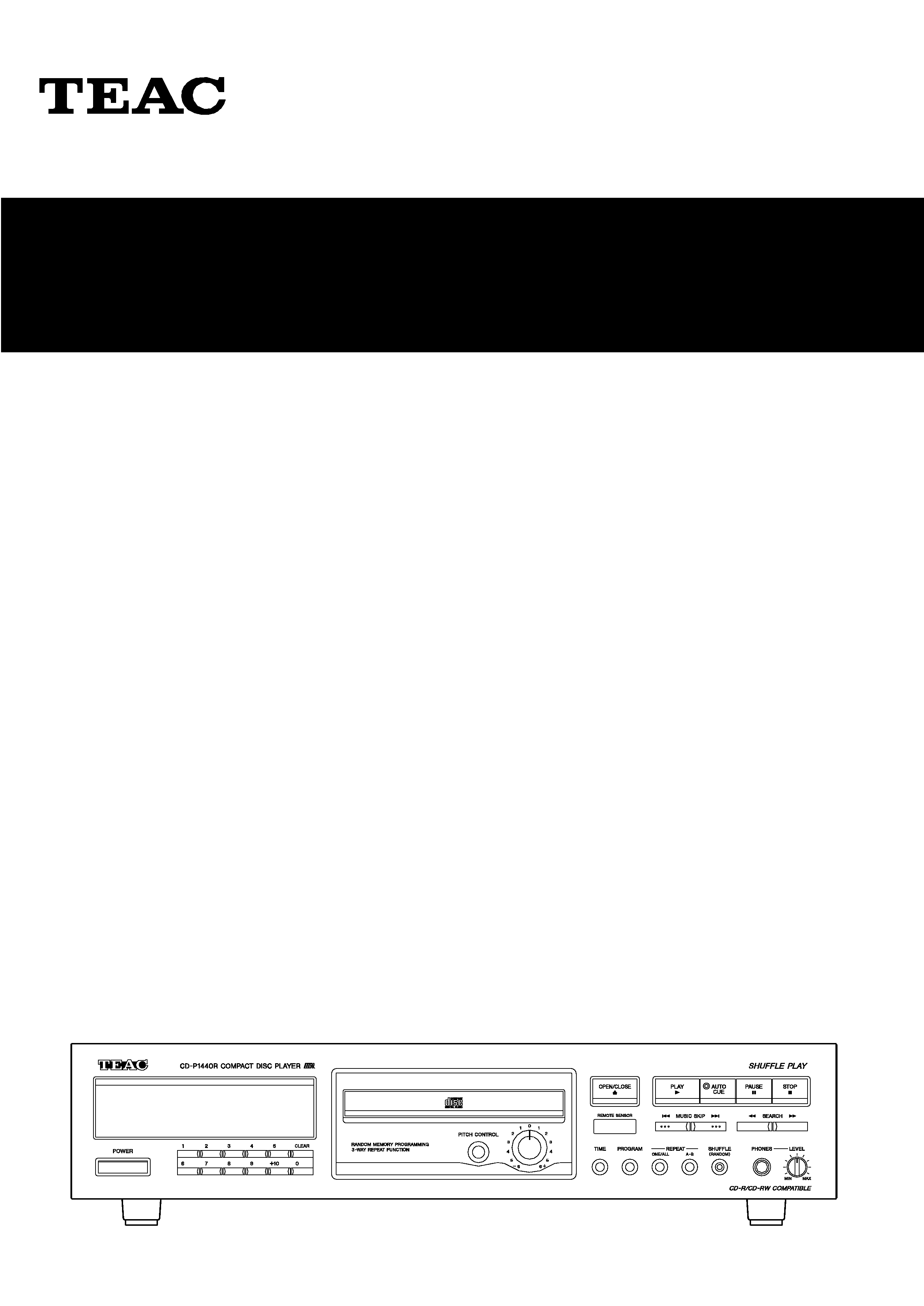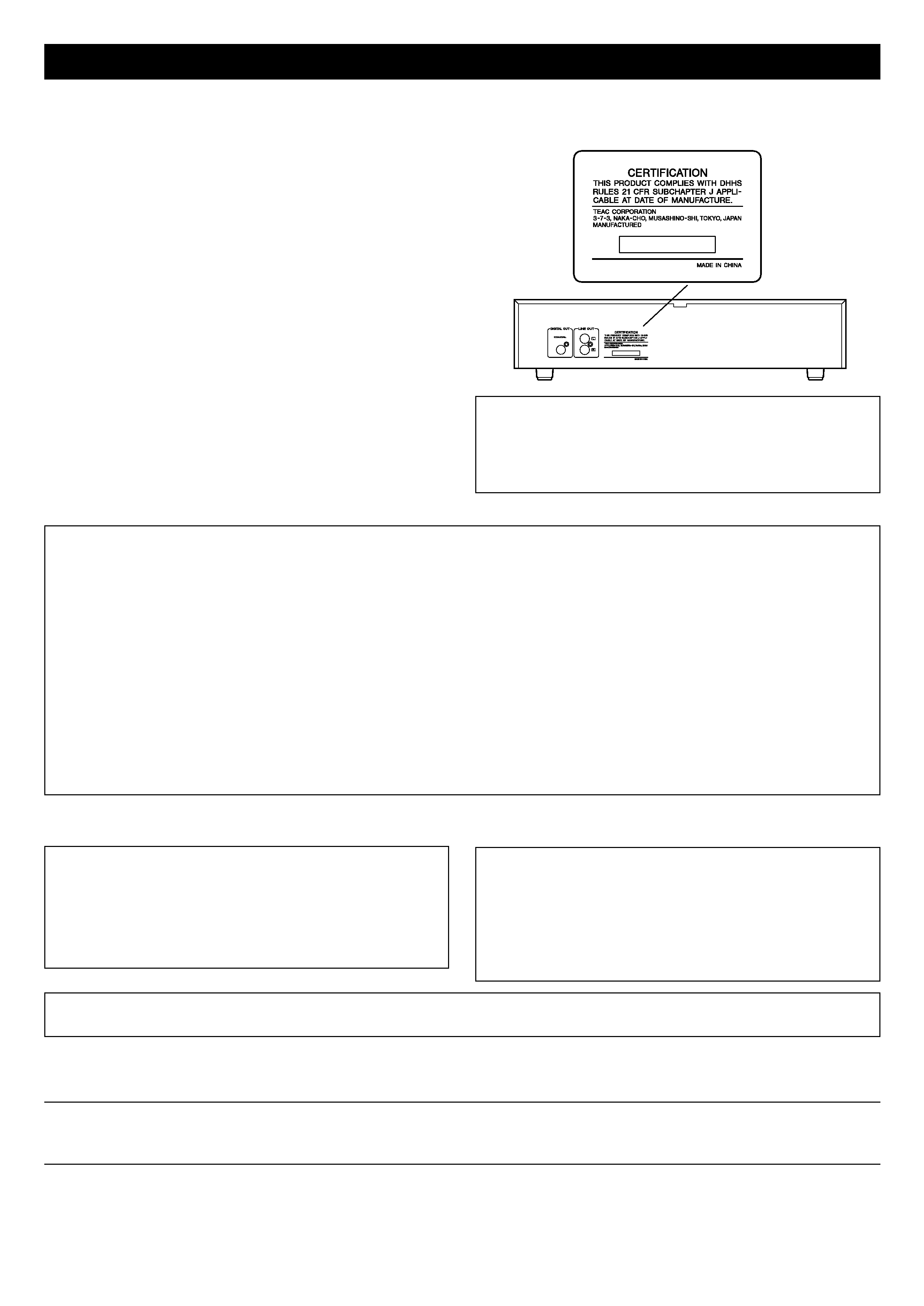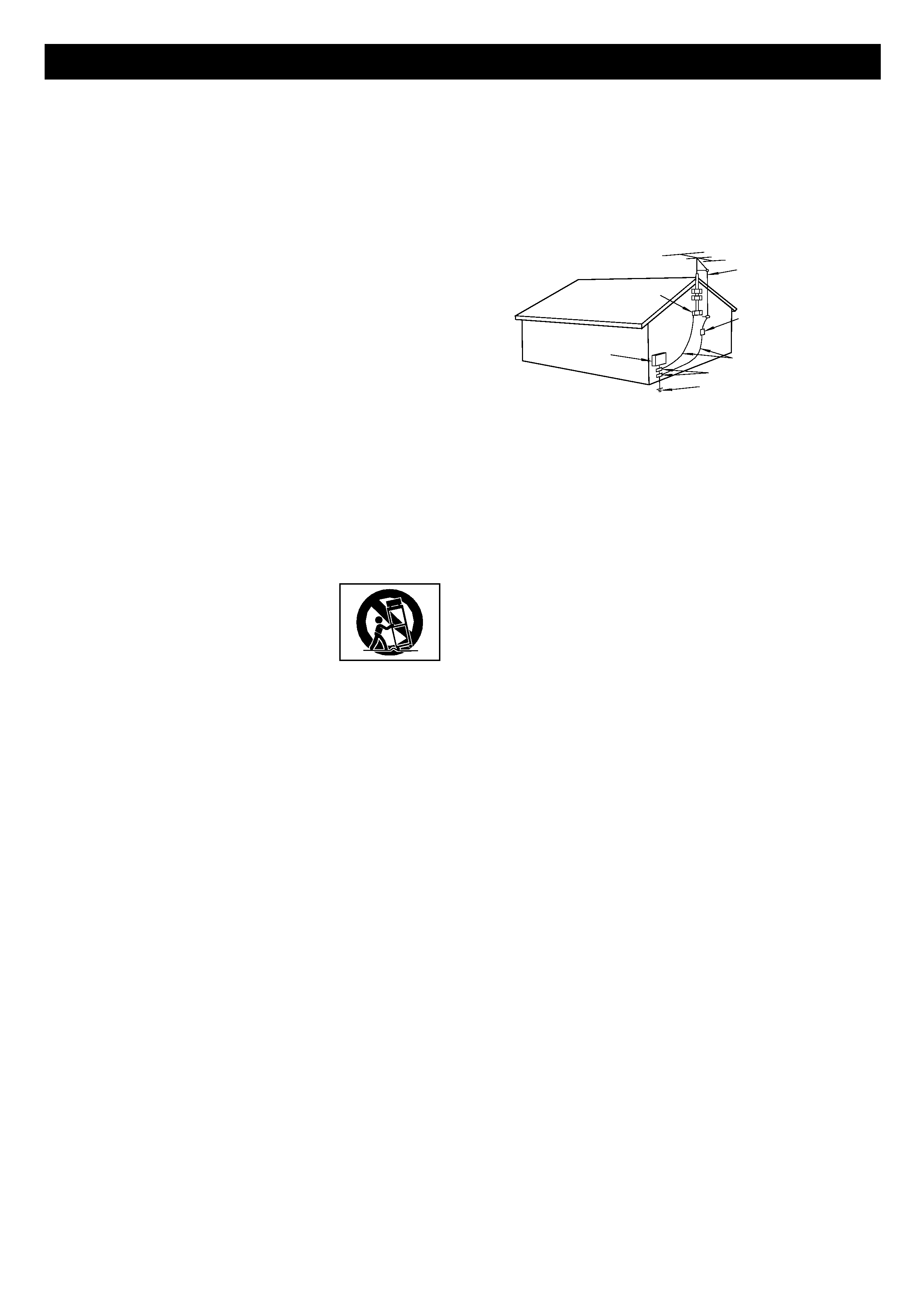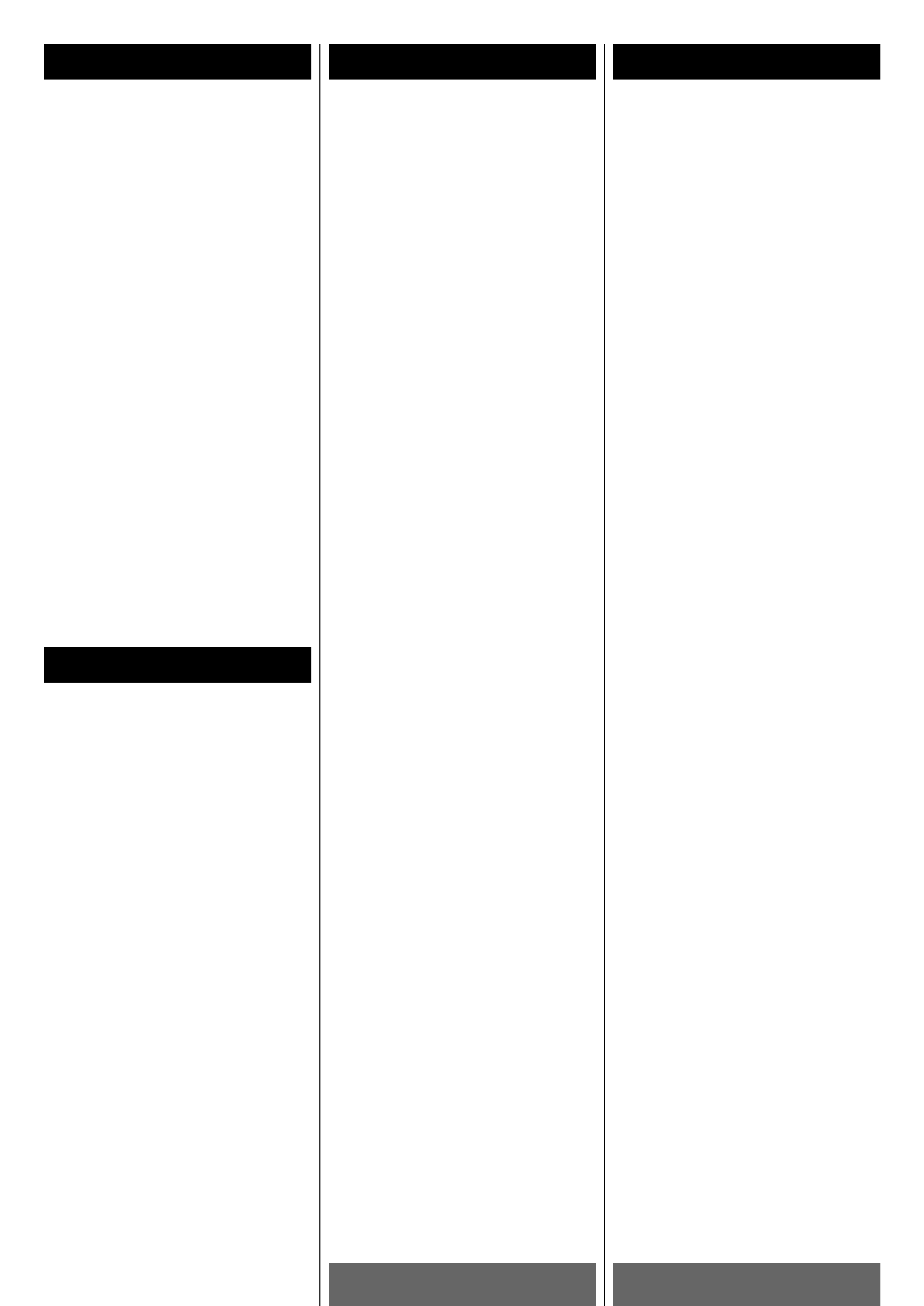
OWNER'S MANUAL
MANUEL DU PROPRIETAIRE
MANUAL DEL USUARIO
MANUAL DO PROPIETARIO
9A09092900
CD-P1440R
Compact Disc Player
?

2
WARNING: TO PREVENT FIRE OR SHOCK HAZARD, DO NOT EXPOSE THIS APPLIANCE TO RAIN OR MOISTURE.
CAUTION: TO REDUCE THE RISK OF ELECTRIC SHOCK, DO NOT REMOVE COVER (OR BACK). NO USER-
SERVICEABLE PARTS INSIDE. REFER SERVICING TO QUALIFIED SERVICE PERSONNEL.
Y
E
R THE EXCLAMATION POINT WITHIN AN EQUILATERAL TRIANGLE IS INTENDED TO ALERT THE USER TO THE PRESENCE OF IMPORTANT
OPERATING AND MAINTENANCE (SERVICING) INSTRUCTIONS IN THE LITERATURE ACCOMPANYING THE APPLIANCE.
THE LIGHTNING FLASH WITH ARROWHEAD SYMBOL, WITHIN AN EQUILATERAL TRIANGLE, IS INTENDED TO ALERT THE USER TO THE
PRESENCE OF UNINSULATED "DANGEROUS VOLTAGE" WITHIN THE PRODUCT'S ENCLOSURE THAT MAY BE OF SUFFICIENT MAGNITUDE TO
CONSTITUTE A RISK OF ELECTRIC SHOCK TO PERSONS.
AC POWER CORD CONNECTION
CAUTION:
TO PREVENT ELECTRIC SHOCK, MATCH WIDE BLADE OF PLUG TO
WIDE SLOT, FULLY INSERT.
CORDE DE CONNEXION CA
ATTENTION:
POUR ÉVITER LES CHOCS ÉLECTRIQUES, INTRODUIRE LA LAME
LA
PLUS
LARGE
DE
LA
FICHE
DANS
LA
BORNE
CORRESPONDANTE DE LA PRISE ET POUSSER JUSQU'AU FOND.
For CANADA
Pour le CANADA
Optical pickup :
TYPE
:
SFP101NXR
MANUFACTURER :
Sanyo Electric Co., Ltd.
LASER OUTPUT
:
Continuous Wave max. 5mW
WAVE LENGTH
:
765-815nm
CAUTION
< DO NOT REMOVE THE PROTECTIVE HOUSING USING
SCREWDRIVER.
< USE OF CONTROLS OR ADJUSTMENTS OR PERFORMANCE OF
PROCEDURES OTHER THAN THOSE SPECIFIED HEREIN MAY
RESULT IN HAZARDOUS RADIATION EXPOSURE.
< IF THIS PRODUCT DEVELOPS TROUBLE, MAKE A CONTACT WITH
OUR SERVICEMAN, AND DO NOT USE THE PRODUCT IN A
TROUBLED STATE.
TO THE USER
This equipment has been tested and found to comply with the limits for a Class B digital device, pursuant to Part 15 of the FCC Rules. These
limits are designed to provide reasonable protection against interference in a residential area. This device generates and uses radio
frequency energy and if not installed and used in accordance with the instructions, it may cause interference to radio or TV reception. If
this unit does cause interference with TV or radio reception you can try to correct the interference by one or more of the following
measures :
a) Reorient or relocate the receiving antenna.
b) Increase the separation between the equipment and the receiver.
c) Plug the equipment into a different outlet so that it is not on the same circuit as the receiver. If necessary, consult the dealer or an
experienced radio/TV technician for additional suggestions.
CAUTION
Changes or modifications to this equipment not expressly approved by TEAC CORPORATION for compliance could void the user's authority
to operate this equipment.
For U.S.A.
Important Safety Instructions
This product has been designed and manufactured according to
FDA regulations "title 21, CFR, chapter 1, subchapter J, based on the
Radiation Control for Health and Safety Act of 1968", and is
classified as class 1 laser product. There is not hazardous invisible
laser radiation during operation because invisible laser radiation
emitted inside of this product is completely confined in the
protective housings.
The label required in this regulation is shown
.
For U.S.A.

ENG/FRA
ESP/POR
3
CAUTION
< Read all of these Instructions.
< Save these Instructions for later use.
< Follow all Warnings and Instructions marked on the audio equipment.
1) Read Instructions -- All the safety and operating instructions should
be read before the product is operated.
2) Retain Instructions -- The safety and operating instructions should
be retained for future reference.
3) Heed Warnings -- All warnings on the product and in the operating
instructions should be adhered to.
4) Follow Instructions -- All operating and use instructions should be
followed.
5) Cleaning -- Unplug this product from the wall outlet before cleaning.
Do not use liquid cleaners or aerosol cleaners. Use a damp cloth for
cleaning.
6) Attachments -- Do not use attachments not recommended by the
product manufacturer as they may cause hazards.
7) Water and Moisture -- Do not use this product near water -- for
example, near a bath tub, wash bowl, kitchen sink, or laundry tub; in a
wet basement; or near a swimming pool; and the like.
8) Accessories -- Do not place this product on an unstable cart, stand,
tripod, bracket, or table. The product may fall, causing serious injury to
a child or adult, and serious damage to the product. Use only with a
cart, stand, tripod, bracket, or table recommended by the manufacturer,
or sold with the product. Any mounting of the product should follow the
manufacturer's instructions, and should use a
mounting accessory recommended by the
manufacturer.
9) A product and cart combination should be
moved with care. Quick stops, excessive force,
and uneven surfaces may cause the product and
cart combination to overturn.
10) Ventilation -- Slots and openings in the cabinet are provided for
ventilation and to ensure reliable operation of the product and to
protect it from overheating, and these openings must not be blocked or
covered. The openings should never be blocked by placing the product
on a bed, sofa, rug, or other similar surface. This product should not be
placed in a built-in installation such as a bookcase or rack unless
proper ventilation is provided or the manufacturer's instructions have
been adhered to.
11) Power Sources -- This product should be operated only from the
type of power source indicated on the marking label. If you are not sure
of the type of power supply to your home, consult your product dealer
or local power company. For products intended to operate from battery
power, or other sources, refer to the operating instructions.
12) Grounding or Polarization -- This product may be equipped with a
polarized alternating-current line plug (a plug having one blade wider
than the other). This plug will fit into the power outlet only one way. This
is a safety feature. If you are unable to insert the plug fully into the
outlet, try reversing the plug. If the plug should still fail to fit, contact
your electrician to replace your obsolete outlet. Do not defeat the safety
purpose of the polarized plug.
13) Power-Cord Protection -- Power-supply cords should be routed so
that they are not likely to be walked on or pinched by items placed upon
or against them, paying particular attention to cords at plugs,
convenience receptacles, and the point where they exit from the
product.
14) Outdoor Antenna Grounding -- If an outside antenna or
cable
system is connected to the product, be sure the antenna or cable
system is grounded so as to provide some protection against voltage
surges and built-up static charges. Article 810 of the National Electrical
Code, ANSI/NFPA 70, provides information with regard to proper
grounding of the mast and supporting structure, grounding of the lead-
in wire to an antenna discharge unit, size of grounding conductors,
location of antenna-discharge unit, connection to grounding electrodes,
and requirements for the grounding electrode.
Note to CATV system installer:
This reminder is provided to call the CATV system installer's attention to
Section 820-40 of the NEC which provides guidelines for proper
grounding and, in particular, specifies that the cable ground shall be
connected to the grounding system of the building, as close to the point
of cable entry as practical."
15) Lightning -- For added protection for this product during a lightning
storm, or when it is left unattended and unused for long periods of time,
unplug it from the wall outlet and disconnect the antenna or cable
system. This will prevent damage to the product due to lightning and
power-line surges.
16) Power Lines -- An outside antenna system should not be located in
the vicinity of overhead power lines or other electric light or power
circuits, or where it can fall into such power lines or circuits. When
installing an outside antenna system, extreme care should be taken to
keep from touching such power lines or circuits as contact with them
might be fatal.
17) Overloading -- Do not overload wall outlets, extension cords, or
integral convenience receptacles as this can result in risk of fire or
electric shock.
18) Object and Liquid Entry -- Never push objects of any kind into this
product through openings as they may touch dangerous voltage points
or short-out parts that could result in a fire or electric shock. Never spill
liquid of any kind on the product.
19) Servicing -- Do not attempt to service this product yourself as
opening or removing covers may expose you to dangerous voltage or
other hazards. Refer all servicing to qualified service personnel.
20) Damage Requiring Service -- Unplug this product from the wall
outlet and refer servicing to qualified service personnel under the
following conditions:
a ) when the power-supply cord or plug is damaged.
b ) if liquid has been spilled, or objects have fallen into the product.
c ) if the product has been exposed to rain or water.
d ) if the product does not operate normally by following the operating
instructions. Adjust only those controls that are covered by the
operating instructions as an improper adjustment of other controls may
result in damage and will often require extensive work by a qualified
technician to restore the product to its normal operation.
e ) if the product has been dropped or damaged in any way.
f ) when the product exhibits a distinct change in performance _ this
indicates a need for service.
21) Replacement Parts -- When replacement parts are required, be
sure the service technician has used replacement parts specified by
the manufacturer or have the same characteristics as the original part.
Unauthorized substitutions may result in fire, electric shock, or other
hazards.
22) Safety Check -- Upon completion of any service or repairs to this
product, ask the service technician to perform safety checks to
determine that the product is in proper operating condition.
23) Wall or Ceiling Mounting -- The product should be mounted to a
wall or ceiling only as recommended by the manufacturer.
24) Heat -- The product should be situated away from heat sources
such as radiators, heat registers, stoves, or other products (including
amplifiers) that produce heat.
ANTENNA
LEAD IN
WIRE
ANTENNA
DISCHARGE UNIT
(NEC SECTION 810-20)
GROUNDING CONDUCTORS
(NEC SECTION 810-21)
GROUND CLAMPS
POWER SERVICE GROUNDING
ELECTRODE SYSTEM
(NEC ART 250. PART H)
NEC - NATIONAL ELECTRICAL CODE
ELECTRIC
SERVICE
EQUIPMENT
Example of Antenna Grounding
as per National Electrical
Code, ANSI/NFPA 70
GROUND
CLAMP
Important Safety Instructions

ENGLISH
FRANÇAIS
Before Use (1)
Avant l'utilisation (1)
4
Lire ceci avant de faire fonctionner
l'appareil
< L'appareil pouvant dégager de la chaleur
lorsqu'il
fonctionne,
laisser
un
dégagement suffisant au-dessus de
l'appareil afin de permettre une
ventilation naturelle.
< La tension d'alimentation de l'appareil
doit être celle indiquée à l'arrière de
l'appareil. En cas de doute, contacter un
électricien.
< Choisir avec soin l'endroit où vous
placerez votre appareil. Eviter de le
placer directement au soleil ou près
d'une source de chaleur. Eviter aussi les
endroits sujets à des vibrations, à de la
poussière excessive, à la chaleur, au
froid ou à l'humidité.
< Ne pas placer CD-P1440R sur le dessus
de l'amplificateur/récepteur.
< Ne pas ouvrir le coffret car ceci
risquerait de provoquer des dommages
aux circuits ou des chocs électriques. Si
un objet rentre dans l'appareil, contacter
votre revendeur.
< Lors du débranchement du cordon
d'alimentation de la prise murale,
toujours tirer sur la fiche et non sur le
cordon.
< Pour garder le capteur laser propre, ne
pas y toucher et ne pas oublier de fermer
le tiroir du disque.
< Ne pas essayer de nettoyer l'appareil
avec des solvants chimiques car ceci
pourrait endommager le fini de l'appareil.
Utiliser un chiffon propre et sec.
< Garder soigneusement ce manuel
d'instructions pour une référence
ultérieure.
Read this before operation
< As the unit may become hot during
operation, always leave sufficient space
above the unit for ventilation.
< The voltage supplied to the unit should
match the voltage as printed on the rear
panel. If you are in any doubt regarding
this matter, consult an electrician.
< Choose the installation location of your
unit carefully. Avoid placing it in direct
sunlight or close to a source of heat. Also
avoid locations subject to vibrations and
excessive dust, heat, cold or moisture.
< Do
not
place
the
unit
on
the
amplifier/receiver.
< Do not open the cabinet as this might
result in damage to the circuitry or
electrical shock. If a foreign object
should get into the set, contact your
dealer.
< When removing the power plug from the
wall outlet, always pull directly on the
plug, never yank the cord.
< To keep the laser pickup clean, do not
touch it, and do not forget to close the
disc tray.
< Do not attempt to clean the unit with
chemical solvents as this might damage
the finish. Use a clean, dry cloth.
< Keep this manual in a safe place for
future reference.
DO NOT MOVE THE UNIT DURING PLAYBACK
During playback, the disc rotates at high
speed. Do NOT lift or move the unit during
playback. Doing so may damage the disc.
WHEN MOVING THIS UNIT
When changing places of installation or
packing the unit for moving, be sure to
remove the disc and return the disc table
to its original position in the player. Then,
press the power switch to turn the power
off, and disconnect the power cord.
Moving this unit with the disc loaded may
result in damage to this unit.
NE
DEPLACEZ
PAS
CET
APPAREIL
PENDANT L'ECOUTE D'UN DISQUE
Pendant une écoute, le disque tourne à
grande vitesse. Ne soulevez pas cet
appareil et ne le déplacez pas pendant
l'écoute d'un disque. En effet, vous
risqueriez d'endommager ce disque.
CONSIGNES DE DEPLACEMENT DE CET
APPAREIL
Lorsque
vous
changez
de
lieu
d'installation ou lorsque vous emballez
cet appareil pour le déplacer, n'oubliez
pas de retirer le disque et de ramener le
plateau à disque à sa position d'origine
dans ce lecteur. Ensuite, appuyez sur le
bouton POWER pour couper la chaîne.
Débranchez le câble électrique. Si vous
déplacez cet appareil alors qu'il contient
un disque, vous risquez d'endommager
cet appareil.
Sommaire
Nous vous remercions pour l'achat d'un
appareil TEAC. Lire ce manuel avec
attention pour obtenir les meilleures
performances possibles de cet appareil.
Avant l'utilisation ........................................ 4
Disques Compacts....................................... 5
Boîtier de télécommande........................... 7
Connexions ................................................... 8
Nomenclature .............................................. 9
Lecture ........................................................ 10
Controle de la hauteur du son
(PITCH CONTROL) ............................... 11
Lecture aléatoire ....................................... 13
Fonction de contrôle d'introductions ..... 13
Lecture programmée ................................ 14
Localisation automatique (AUTO CUE) ... 16
Fonction de répétition............................... 17
Affichage du temps ................................... 19
Dépannage ................................................. 20
Caractéristiques ........................................ 21
Contents
Thanks for buying a TEAC. Read this manual
carefully to get the best performance from
this unit.
Before Use .................................................... 4
Compact Disc ............................................... 5
Remote Control Unit .................................... 7
Connections.................................................. 8
Name of Each Control................................. 9
Playback...................................................... 10
Pitch Control ............................................... 11
Shuffle Playback ........................................ 13
Intro Check ................................................. 13
Programmed Playback ............................. 14
Auto Cue...................................................... 16
Repeat Playback ........................................ 17
Time Display ............................................... 19
Troubleshooting ......................................... 20
Specifications ............................................ 21

ENG/FRA
ESP/POR
FRANÇAIS
5
ENGLISH
Compact Disc (1)
Disques Compacts (1)
Discs which can be used with this unit:
Conventional audio CDs
Properly finalized CD-R and CD-RW discs
Note:
Depending on the quality of the disc
and/or the condition of the recording,
some CD-R & CD-RW discs may not be
playable.
< Always place the disc on the disc tray
with the label side uppermost. (Compact
discs can be played or recorded only on
one side.)
< To remove a disc from its storage case,
press down on the center of the case and
lift the disc out, holding it carefully by the
edges.
How to remove the disc
How to hold the disc
< Should the disc become dirty, wipe the
surface radially with a soft, dry cloth : C
B
A
Disques compatibles avec cet appareil:
Compact Disc (CD) audio conventionnel
CD-R
et
CD-RW
qui
ont
été
convenablement finalisés.
Note:
Dépendant de la qualité du disque et/ou
la condition de l'enregistrement, certain
disques CD-R et CD-RW ne joueront pas.
< Placer toujours le disque sur le plateau,
la face imprimée sur le dessus (les
disques compacts ne sont enregistrés
que sur une seule face.)
< Pour sortir un disque de son emballage,
appuyer sur la partie centrale de l'étui et
sortir le disque en veillant à bien le tenir
par les bords.
Comment sortir un disque de son
emballage
Comment tenir le disque
< Si la surface du disque est sale, l'essuyer
soigneusement à l'aide d'un chiffon doux
et sec : C
B
A
Before Use (2)
Avant Utilisation (2)
Risque de condensation
En cas de déplacement de l'appareil (ou
d'un disque) d'un endroit froid vers un
endroit chaud, ou en cas d'utilisation
après un changement de température
brutale, il y a un risque de condensation.
La vapeur contenue dans l'air peut se
condenser sur le mécanisme interne et
affecter le bon fonctionnement de
l'appareil. Pour éviter ceci, ou au cas où
cela venait à se produire, laisser
l'appareil sous tension pendant une
heure ou deux. Ceci lui permettra de se
stabiliser à la température ambiante.
Entretien
Si la surface de l'appareil devient sale,
nettoyer celle-ci à l'aide d'un chiffon
doux ou utiliser un liquide de nettoyage
neutre. La nettoyer entièrement. Ne pas
utiliser de diluant, de benzine ou d'alcool
car ils risquent d'endommager la surface
de l'appareil.
Beware of condensation
When the unit (or a disc) is moved from a
cold to a warm place, or used after a
sudden temperature change, there is a
danger of condensation; vapor in the air
could
condense
on
the
internal
mechanism, making correct operation
impossible. To prevent this, or if this
occurs, leave the unit for one or two
hours with the power turned on. Then the
unit will stabilize at the temperature of its
surroundings.
Maintenance
If the surface of the unit gets dirty, wipe
with a soft cloth or use diluted neutral
cleaning liquid. Be sure to remove any
fluid completely. Do not use thinner,
benzine or alcohol as they may damage
the surface of the unit.
A
C
B
